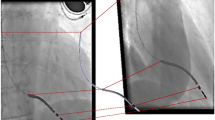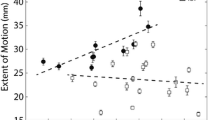Abstract
Although cardiac resynchronization therapy (CRT) is an effective treatment for chronic systolic heart failure with dyssynchrony, about one-third of patients do not respond favorably. The interaction between the pacing lead and the coronary sinus (CS) branches is of paramount importance for an effective resynchronization. Minor changes in lead position overtime could interfere with CRT mechanics, without affecting even biophysical parameters or ECG morphology. Although late post-implant CS lead dislodgement rate is consistent, lead movements have been little investigated and only with bi-dimensional methods. The aim of this study was (1) to develop a method for quantifying CS lead position in the 3D domain throughout the cardiac cycle and (2) to test it by comparing the CS lead position at implant and at follow-up, using chest fluoroscopy. Method performance, its accuracy and reproducibility were qualitatively and quantitatively assessed. Intra- and inter-observer percent discordance between trajectories were also computed. The accuracy of the procedure resulted in 0.3 ± 0.1 mm and its resolution was 0.5 mm. Intra- and inter-observer discordances were 2.2 ± 1.5 and 5.5 ± 3.6 mm, respectively. The proposed method for measuring the CS lead dynamic placement in 3D space seems accurate and reproducible. Investigating CS lead 3D dynamics could provide further insights into CRT mechanics.








Similar content being viewed by others
References
Abraham WT (2002) Cardiac resynchronization in chronic heart failure. N Engl J Med 346:1845–1853
Barron JL, Fleet DJ, Beauchemin SS (1994) Performance of optical flow techniques. Int J Comput Vis 12(1):43–77
Becker M (2010) Analysis of LV lead position in cardiac resynchronization therapy using different imaging modalities. JACC Cardiovasc Imaging 3(5):472–481
Bogaard MD, Doevendans PA, Leenders GE, Loh P, Hauer RNW, van Wessel H, Meine M (2010) Can optimization of pacing settings compensate for a non-optimal left ventricular pacing site? Europace 12(9):1262–1269
Bristow MR (2004) Cardiac-resynchronization therapy with or without an implantable defibrillator in advanced chronic heart failure. N Engl J Med 350:2140–2150
Bulava A et al (2005) Postmortem anatomy of the coronary sinus pacing lead. Pacing Clin Electrophysiol 28:736–739
Bulava A (2007) Single-centre experience with coronary sinus lead stability and long-term pacing parameters. Europace 9:523–527
Camus T (1997) Real-time quantized optical flow. J Real Time Imaging 3:71–86
Cleland JGF (2005) The effect of cardiac resynchronization on morbidity and mortality in heart failure. N Engl J Med 352:1539–1549
Figueroa PJ (2003) A flexible software for tracking of markers used in human motion analysis. Comput Methods Programs Biomed 72(2):155–165
Galvin B (1998) Recovering motion fields: an evaluation of eight optical flow algorithms. In: Proceedings of British Machine Vision Conference, BMVA Press, pp 195–204
Golemati S et al (2003) Carotid artery wall motion estimated from B-mode ultrasound using region tracking and block matching. Ultrasound Med Biol 29(3):387–399
Gorscan J (2008) Echocardiographic assessment of ventricular dyssynchrony. Curr Cardiol Rep 10(3):211–217
Gras D (2007) Implantation of cardiac resynchronization therapy systems in CARE-HF trial: procedural success rate and safety. Europace 9:516–522
Kasravi B et al (2005) Coronary sinus lead extraction in the era of cardiac resynchronization therapy: single center experience. Pacing Clin Electrophysiol 28:51–53
Khan ZF (2009) Left ventricular lead placement in cardiac resynchronization therapy: where and how? Europace 11:554–561
Kumar P (2010) Assessment of the post-implant final left ventricular lead position: a comparative study between radiographic and angiographic modalities. J Interv Cardiac Electrophysiol 29(1):17–22
Leon AR (2005) Safety of transvenous cardiac resynchronization system implantation in patients with chronic heart failure: combined results of over 2,000 patients from a multicenter study program. J Am Coll Cardiol 46:2348–2356
McAlister FA (2007) Cardiac resynchronization therapy for patients with left ventricular systolic dysfunction: a systematic review. JAMA 297(22):2502–2514
Stoitsis J, Golemati S, Dimopoulos AK, Nikita KS (2005) Analysis and quantification of arterial wall motion from B-mode ultrasound images—comparison of block-matching and optical flow. In: IEEE engineering in medicine and biology society, IEEE press, pp 1758–1761
Tang WH (2008) Relation of mechanical dyssynchrony with underlying cardiac structure and performance in chronic systolic heart failure: implications on clinical response to cardiac resynchronization. Europace 10:1370–1374
Valstar ER (2001) Digital Roentgen stereophotogrammetry: development, validation, and clinical application. Ph.D. Thesis, Leiden University
Veronesi F et al (2006) Tracking of left ventricular long axis from real-time three-dimensional echocardiography using optical flow techniques. IEEE Trans Inf Technol Biomed 10:174–181
Veronesi F et al (2009) A study of functional anatomy of aortic-mitral valve coupling using 3D matrix transesophageal echocardiography. Circ Cardiovasc Imaging 2(1):24–31
Yu CM et al (2005) LV reverse remodeling but not clinical improvement predicts long-term survival after cardiac resynchronization therapy. Circulation 112:1580–1586
Acknowledgment
We would like to thank Roberta Mosconi and Federico Veronesi for contributing to this study and Riccardo Pepoli, Giorgio Bevilacqua, and Anna Galli for image acquisition.
Author information
Authors and Affiliations
Corresponding author
Rights and permissions
About this article
Cite this article
Corsi, C., Tomasi, C., Turco, D. et al. 3D dynamic position assessment of the coronary sinus lead in cardiac resynchronization therapy. Med Biol Eng Comput 49, 901–908 (2011). https://doi.org/10.1007/s11517-011-0794-3
Received:
Accepted:
Published:
Issue Date:
DOI: https://doi.org/10.1007/s11517-011-0794-3




